Proper use of barberry in landscape design for maximum aesthetics
Manifold garden crops, a large number of varieties of ornamental plants opens up enormous opportunities when developing landscape design. However, with such a variety, you can get confused, not knowing where to choose.
However, there are several basic types of plants that are widely used in landscape architecture - their presence gives the garden space a special charm. For example, barberry - this is exactly what we will talk about in this article. We will talk about how it began to be used as an ornamental plant and why over time it is used again and again in landscape design.
Some facts about barberry
Common barberry (Berberis vulgaris) belongs to the family Berberidaceae (Barberry), subfamily Berberidideae, a tribe of flowering plants Berberideae, is part of the genus Barberry (Berberis) and belongs to the order of dicotyledonous flowering plants Ranunculales (Ranunculaceae).
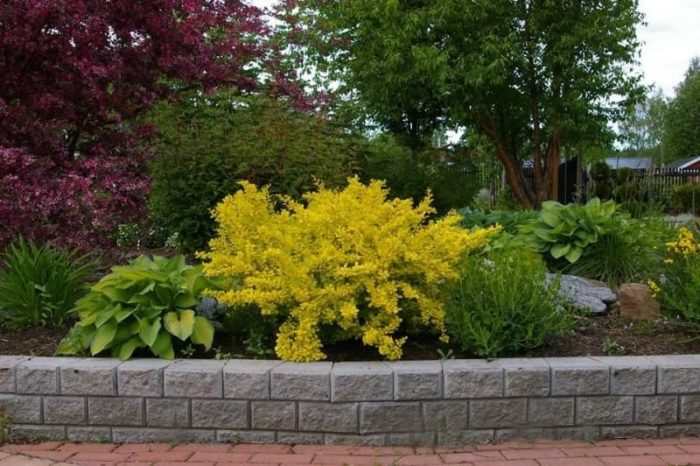
In descriptions it first appears in the botanical illustration of the book “Flora of Germany, Austria and Switzerland” (Flora von Deutschland, Österreich und der Schweiz), authored by Prof. dr. Thomé, 1885 edition.
Barberry has been used in landscape design for a very long time - it has been used since the emergence of Babylonian gardens.
Such constancy and demand are due to the decorative properties of the plant and its unpretentiousness. Thanks to these qualities, it has maintained its popularity over the centuries and to this day is a constant attribute of landscape architecture.
Barberry gained fame long before it was scientifically classified. It is believed that its name comes from Arabic berbaris — "Berber shell", due to the similarity of the small oblong fruits of the plant. In addition, barberry was actively used in folk medicine; healing properties were attributed to its flowers and leaves. It was used in ancient India and other countries where it was widespread, and honey was made from it.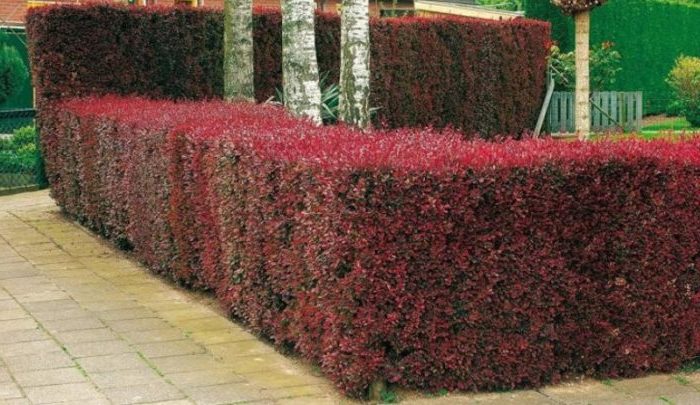
Before the common barberry became widespread, its habitat was concentrated in East Asia; the plant was also found in some forest-steppe areas of southern Europe and Transcaucasia. Barberry loves light, so it is common in open areas. Its typical habitats are lawns, forest edges, and mountain slopes at an altitude of up to two thousand meters.
Popular ornamental varieties
The most popular varieties are listed below.
We also recommend that you read the article Barberry Thunberg Aurea - description and application in landscape design.
Barberry Thunberg "Green Carpet"
Mature plants can grow up to 1 meter in height, its leaves are bright green, evenly colored. The plant blooms in May, its flowers are bright red and have a yellow center.
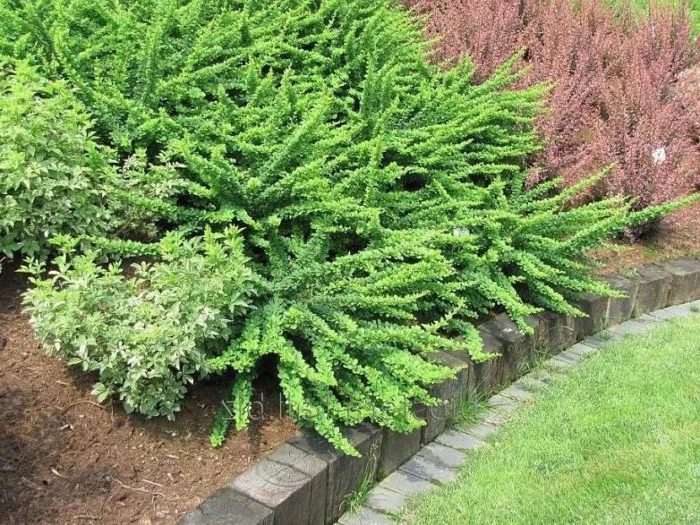
By autumn, the foliage acquires a purplish-orange tint; in September, bright red fruits appear in the form of oblong berries with a glossy sheen, which can remain on the bush all winter.
Barberry Thunberg "Golden Ring"
This course can grow up to 2.5 meters in height and has a rounded shape. The color of the leaves is crimson, with a golden edging around the perimeter, thanks to which the variety received the name “Golden Ring”.

Yellow flowers with a red center bloom in May. The beginning of autumn is the period of ripening of red berries. This is perhaps one of the most spectacular varieties of barberry.
Barberry Thunberg "Atropurpurea" (Atropurpurea)
Dense spreading shrub, can reach 1.5 meters in height. The leaves are dense, rounded, rich purple in color. The flowers are bright yellow and bloom in May. Well suited for forming hedges, but requires regular trimming.
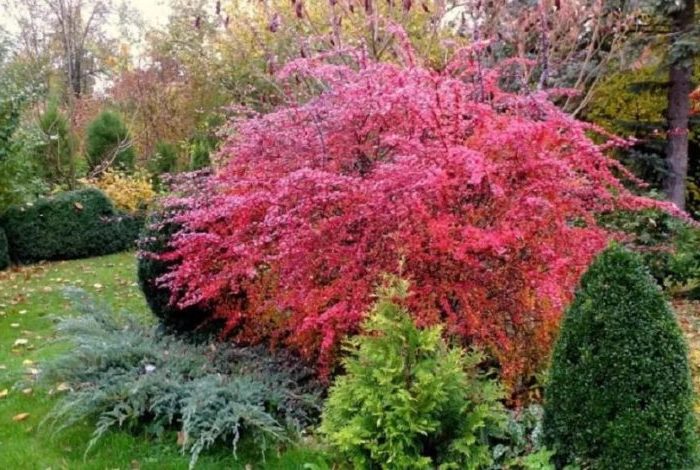
Barberry Thunberg "Atropurpurea Nana" (Atropurpurea Nana)
A variety of barberry with a dense dense crown, reaching a height of 1 m. It has purple foliage of a soft shade, which becomes more saturated in autumn.
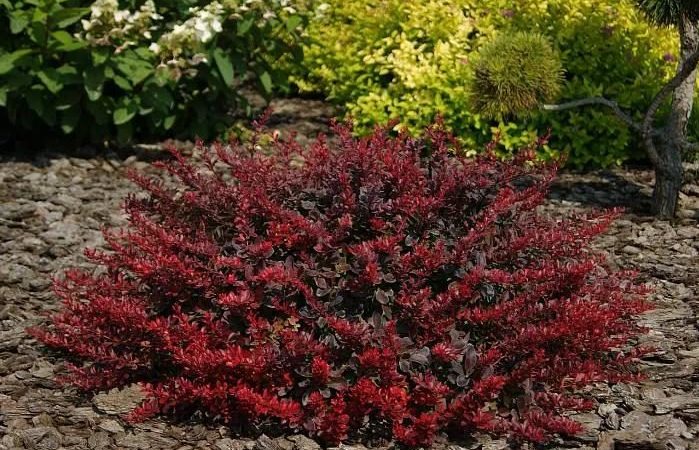
In May, the shrub blooms profusely; the blooming flowers have small red petals and a yellow center. Deep purple berries appear in autumn.
Barberry thunberg "Darts Red Lady" (Darts Red Lady)
This is a low dense shrub, no more than 0.8 meters in height. The glossy leaves can change shade, depending on the viewing angle, in sunlight they can look deep purple or brown, and in the fall they take on a striking orange color.
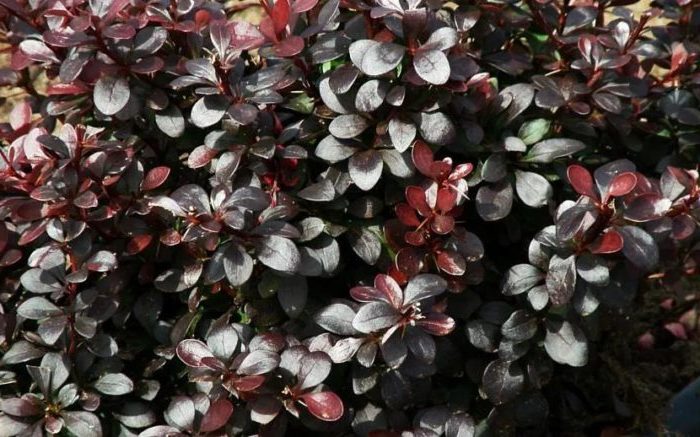
This variety of barberry blooms throughout May; the shrub is distinguished by yellow flowers with a carmine transition, standing out against the background of dark foliage, as well as graceful berries.
Barberry thunberg "Red Rocket"
The shrub has an elongated crown, reaching a height of 2 meters, and its foliage is purple in color, due to which this type of barberry was called the “Red Rocket”.
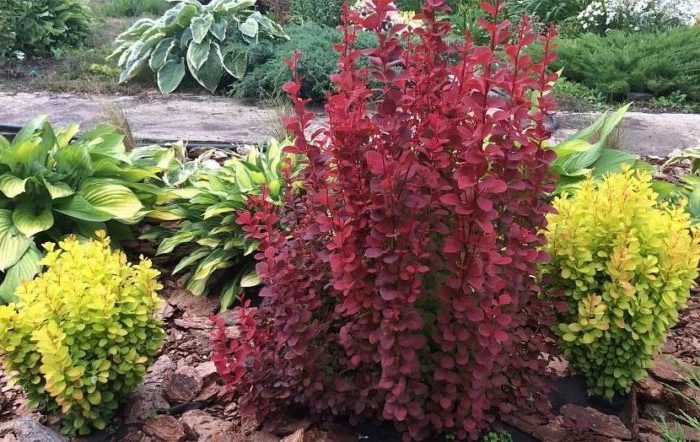
Interestingly, by autumn, when the foliage color of most plants turns yellow or red, the foliage of the Red Rocket, on the contrary, turns green. With age, the girth of the shrub can reach six meters, which must be taken into account when choosing a place for planting. This species blooms in May; in the fall, characteristic red berries form on the bush.
Barberry thunberg "Golden Horizon"
Low shrub up to 0.7 meters high. It is usually planted in the foreground; it has matte foliage of a catchy golden-green color. By autumn it takes on a bright orange hue.
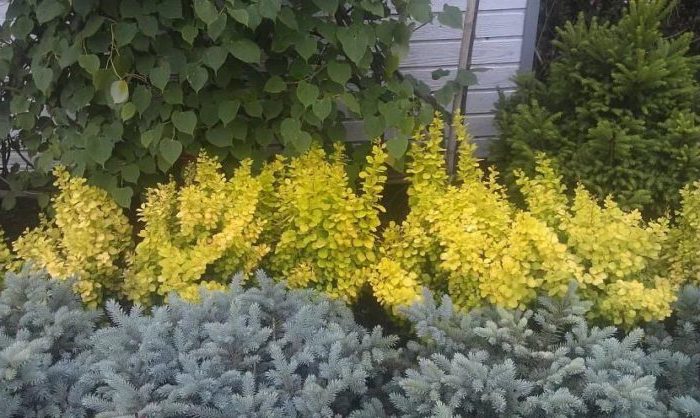
Creamy yellow flowers bloom in May. The berries are red and small in size. In summer, the rich yellow shrub looks very interesting.
Barberry thunberg "Maria" (Maria)
This unusual variety has a spike-shaped crown reaching one and a half meters in height. The peculiarity of this variety is that over the course of the season the foliage of the shrub gradually changes color and becomes alternately green, golden, pinkish, purple and brown. Thanks to this, the garden looks new every time.

Flowers with yellow petals bloom in May, with red berries forming by autumn.
Barberry Thunberg Rose Glow
A spreading shrub characterized by an unusual purple-pink coloring of the leaves. On old shoots they have a purplish color, and new growth is distinguished by silvery-pinkish veins on the foliage. The shoot has a rich red color.

It blooms for several weeks, starting at the end of May.
Barberry Ottawa
This variety was artificially bred by crossing the purple form of the common barberry with the Thunberg barberry. It was first demonstrated in Ottawa, the capital of Canada. A tall shrub reaching 2-3 meters in height. The shape and height of the crown vary depending on the variety.
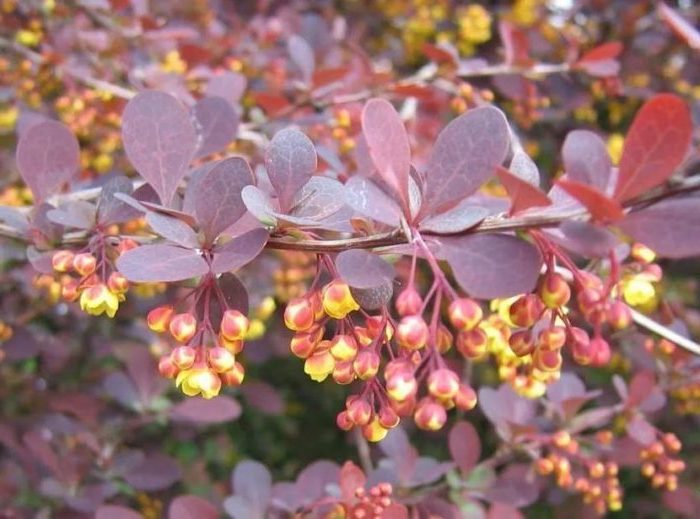
It is perfect for forming hedges, which is why it has gained popularity. Its other advantages include good frost resistance and rapid growth, it can grow up to 35 cm in height per year.
Barberry spherical
A tall shrub from its natural habitat, reaching a height of 2.5 meters. This variety was brought from Asia to Europe. It differs from other varieties in the dark blue color of the berries with a bluish bloom and the less striking color of the foliage, which has a grayish-green tint. The fruits of this barberry variety have a good taste and are suitable for use in cooking.
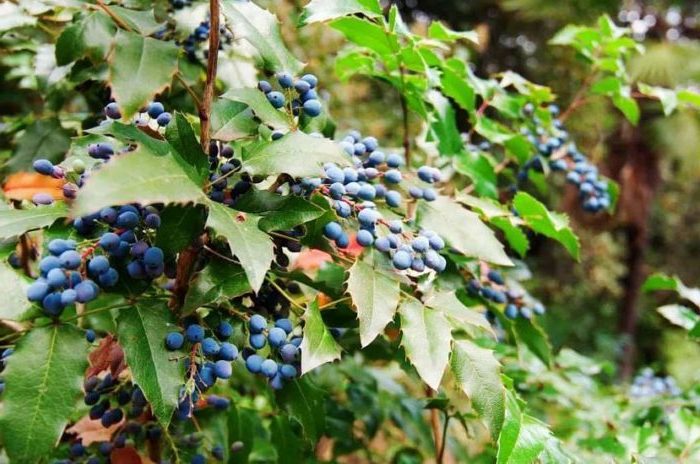
The downside is lower frost resistance compared to other varieties of the family.
The use of barberry in landscape design
It is no coincidence that barberry received the love and recognition of gardeners. The huge variety of shapes and sizes of the shrub allows it to be used in a variety of compositions, and its beautiful colors attract attention. The variety and richness of the foliage color palette, beautiful flowering and bright berries make this shrub an indispensable decorative element in landscape design.
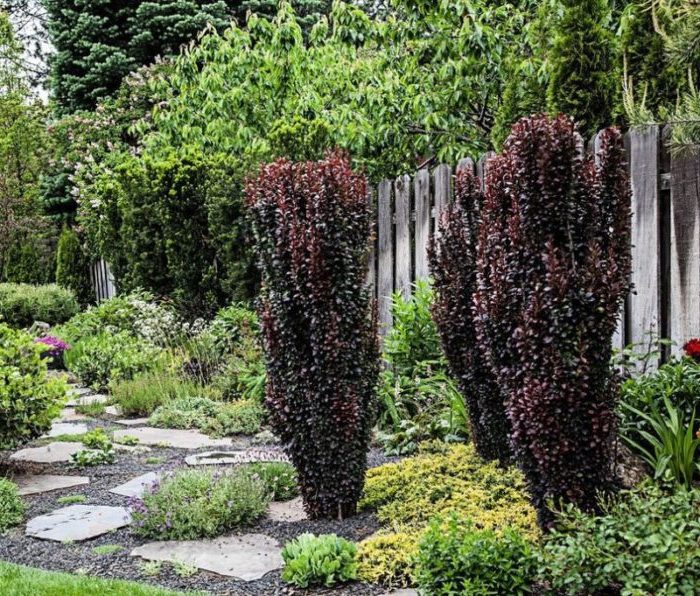 This plant invariably arouses and maintains interest not only among inexperienced gardeners, but also among experienced landscape designers. The unpretentiousness of barberry and its beauty, which lasts throughout the season, ensure the undying popularity of this plant in landscape architecture.
This plant invariably arouses and maintains interest not only among inexperienced gardeners, but also among experienced landscape designers. The unpretentiousness of barberry and its beauty, which lasts throughout the season, ensure the undying popularity of this plant in landscape architecture.
Barberry gets along well with other plants, but when choosing a planting site, a number of conditions must be observed. For example, cherry, poplar, elderberry and walnut can release chemicals that negatively affect the growth of barberry, which can lead to the gradual death of the plant.
Forming a hedge
Perennial shrubs acquire strong thorns on their branches, which makes it possible to use barberry to form a hedge. Due to the density of the plant, the fence becomes almost impenetrable.

Advantages of using barberry as a hedge:
- Dense foliage carefully disguises thorns, the fence does not look aggressive.
- Such a fence has the maximum impassability among all types of plants; not only people, but also animals cannot overcome it.
- The hedge looks beautiful throughout the year thanks to its beautiful flowering, lush bright foliage and rich berry color.
Thanks to the varieties of barberry that differ in height, it can be used in one area for different purposes.For example, tall shrubs can be planted to hide part of the territory from prying eyes, medium-height varieties allow you to zone the territory, and low-growing varieties are well suited for forming paths, framing borders and flower beds.
Solitaire planting
Solitaire planting, solitaire (from lat. solitarius — lonely) is a method of planting plants designed to focus attention on a certain part of the garden composition.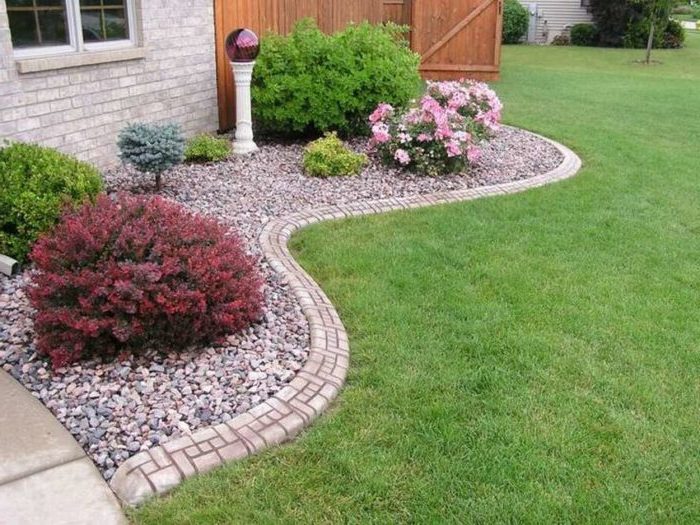
With this method, a single plant or an isolated compact group of plantings is planted on a site. The same method achieves visual expansion of small areas.
When decorating a tapeworm, it is necessary to maintain a 1:3 proportion - the height of the plant should be a third of the width and length of the area.
Barberry perfectly camouflages unsightly walls, outbuildings and everything that needs to be hidden from prying eyes. If you adhere to the rules described above, you can successfully correct the symmetry of the site with geometric disproportions and beautifully decorate the entrance to the estate.
Decoration of flower beds
The variety of barberry colors, shapes and sizes of shrubs opens up wide scope for creativity and the implementation of various ideas for designing flower beds. For example:
- barberry is equally good when space is limited (as a single accent) and for zoning a large area (when forming borders);
- in double-sided flower beds, the shrub perfectly forms the required volume and creates tiers;
- low-growing varieties are good for forming borders in large flower beds, and medium-growing varieties are excellent for solitary planting;
- if you want to create an area that remains decorative for a long time, barberry will do this role perfectly, since its foliage maintains color saturation throughout the season;
- well suited for flower beds with a predominance of tall plant species, while tall and short varieties of barberry can be combined;
- Thanks to the variety of varieties, the number of possible combinations is practically unlimited, and barberry can be combined with many other plants.
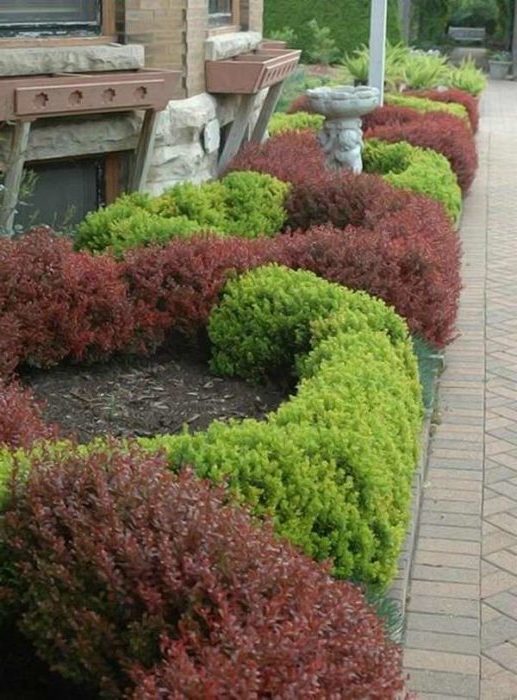
How to grow barberry
You can grow barberry all year round. There are several ways to propagate a plant:
- Autumn is good for dividing bushes and harvesting shoots for planting in the spring. open ground. Planting rooted cuttings in the fall is more favorable, since during the winter the plant has time to prepare for growth and development in the spring.
- In the spring, in April and May, in addition to planting cuttings rooted over the winter, you can propagate barberry by dividing the bush.
- Summer is good for barberry bush trimmings and cuttings.
In this case, vegetative methods of propagation are most widespread, since they are the simplest and most effective. But dividing the bush and cuttings are not the only methods of propagation. It is also possible to breed barberry using seeds. The pollination process cannot be controlled, so the result may be unusual. As a rule, plants obtained from seeds differ significantly from the parent ones in the shape of the bush, as well as in the colors of the leaves and flowers.
Compared to other plants, barberry is quite easily propagated by seeds. You only need to take into account a few rules:
- Seeds should be collected in late autumn directly from the bush.
- After harvesting, they must be cleaned of the remaining berry pulp, dried and stored until the end of winter.
- In mid-February, soak the seeds in water for two days, keep them in a closed container outside for 3 days; if the winter is warm, place them in the freezer.
- Then store the seeds at room temperature.
- Plant them in the greenhouse after they have swelled.
Growing and care
One of the advantages of barberry is its extreme unpretentiousness. This shrub has very low requirements for soil acidity and its structure. Before planting, just add fertilizer or a nutrient mixture - and the shrub will feel great for a long time. The only condition that must be observed is good soil drainage, since the plant does not tolerate excess moisture and quickly dies when water stagnates.
From the second year after planting, you can begin to feed the bushes, this promotes more intense flowering and improves the condition of the foliage. Weeding is also beneficial for barberry.
Conclusion
The variety of varieties and spectacular appearance of barberry are so good that its popularity has not faded for centuries. The variety of options for its use and the ability to create many compositions have long inspired breeders to develop new varieties, and designers to use them in landscape architecture. Thanks to this, barberry is becoming increasingly widespread and continues to delight all gardeners who are not indifferent to it.